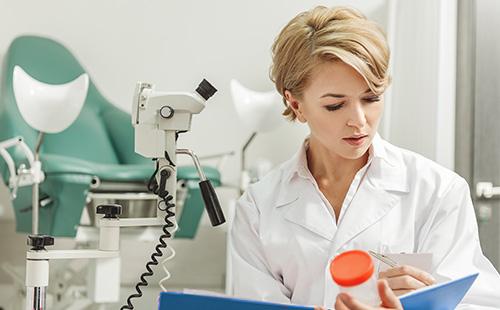The content of the article
Most women in different periods of life experienced discomfort and increased discharge. Timely treatment got rid of many problems. And some are constantly suffering from recurrence of vulvovaginitis. This means that factors that trigger the pathological process are preserved. That is, only the consequences were treated, and not the cause.
About pathology
With inflammation of the external genitalia, the reaction can affect only the vestibule of the vagina, the area between the labia. Then develop vulvit. If the pathological process simultaneously captures the walls of the vagina, then it is vulvovaginitis. The disease can occur in the following forms:
- spicy;
- subacute;
- chronic
An extremely complicated degree of chronic vulvovaginitis with frequent exacerbations is vaginal ulceration or abscess. Long-standing inflammation leads to atrophy of the mucous membrane. This condition can become a background for hypreplastic processes. Atrophic vaginitis is dangerous by increasing the risk of developing cancer. In ICD-10, codes N76.0-5 are reserved for vulvovaginitis of all forms, as well as vulvar abscess and vaginal ulceration.
"Start" for the disease
The causes of vulvovaginosis are associated with the rapid reproduction of opportunistic flora and a decrease in protective factors. With a normal hormonal background, a sufficient amount of estrogen in the vagina there are all conditions for the multiplication of lactic acid bacteria. Other microorganisms may be present, but their number is insignificant, and vital activity does not lead to an inflammatory response. There are no visible symptoms of the disease.
Specific and non-specific flora can lead to vulvovaginitis. Key representatives are compiled in a table.
Table - Pathogens of vulvovaginitis
| Specific | Nonspecific (conditionally pathogenic) |
|---|---|
| - Gonococcus; - Trichomonas; - chlamydia | - Candidates; - urea and mycoplasmas; - streptococci; - E. coli; - staphylococci; - bacteroids; - enterococci |
Detection of any conditionally pathogenic flora in the smear does not matter if the titer is low during bacteriological examination and there are no clinical symptoms. This condition does not require treatment. But during pregnancy, even small titers of opportunistic microorganisms without a combination with clinical manifestations are subject to treatment.
Certain conditions are needed to reduce protection factors. Often they depend on lifestyle or other pathological conditions.
- Medications. Antibiotic treatment destroys pathogens, but also affects the normal microflora. Therefore, after infectious diseases treated with antibiotics, candidiasis should be expected, vaginal dysbiosis and intestines. Cytostatics are negatively affected. Glucocorticoid hormones do not affect the microflora itself, but significantly reduce immunity.
- Hormonal changes. Physiologically during pregnancy, before menstruation, there is a change in the concentration of hormones relative to each other. This can affect the state of microflora. Period menopause - This is a decrease in ovarian function and a lack of estrogen. Therefore, atrophic changes are observed in the vagina, during which inflammation easily occurs.
- Endocrine pathology. Diabetes mellitus, thyroid disease are accompanied by changes in immunity. This affects the ability of the vagina to protect and self-clean.
- Severe illness. As well as operations, injuries that require long-term treatment, are accompanied by depletion of protective forces.
- Genital infections. When unprotected sex is transmitted gonorrhea, chlamydiatrichomoniasis. Candidiasis and opportunistic microbes do not belong to this category, but with a change in sexual partner, vaginitis may worsen.
- Hygiene features. Neglect of hygiene rules, as well as their excessive observance, can cause symptoms of vulvovaginitis. The use of flavored sanitary pads, a rare change of tampons upset the balance of microflora. Douching leaches normal flora, and conditionally pathogenic microorganisms begin to multiply actively in its place.
How does it manifest ...
Vulvovaginal infections! You can suspect the onset of vaginal inflammation by the appearance of secretions. Normally, their number is small and can only increase during ovulation and before menstruation. It is reliably possible to claim the presence of inflammation if the discharge changes its character. They can become the following:
- plentiful;
- liquid;
- thick;
- white with various shades;
- foamy;
- with an unpleasant odor.
The nature of the discharge and additional symptoms suggest the pathogen. For example, signs of candidal vulvovaginitis are white curdled discharge with grains that are accompanied by itching and burning.
... and what confirms
For diagnosis, you need to see a doctor. It is impossible to independently identify the causative agent of the disease without analysis. Some conditions are accompanied by a combination of several microorganisms. Therefore, the treatment will be selected comprehensively. Diagnostics includes the following methods.
- Smear. Detachable vagina is applied to a glass slide. In the laboratory, the composition of the microflora is determined: the predominant flora, the number of leukocytes, mucus, pathogenic microorganisms.
- Bakposev. To determine the morphological properties of a particular microorganism, the precipitates are seeded on a special nutrient medium. This allows you to determine their sensitivity to antibiotics.
- PCR. Sometimes there are no pathogens in the smear, and there are clinical symptoms of the disease. Then resort to PCR, which determines the presence of pathogen DNA in the test material. Modern techniques allow us to do this not only qualitatively, but also quantitatively.
Sometimes such studies as a hormonal profile, biochemical blood test, ultrasound of the pelvic organs are necessary.

Treatment of vulvovaginitis in women: basic techniques
You can cure vulvovaginitis at home, hospitalization is not required. But you need to start with lifestyle changes.
- Hygiene. Choose linen made from natural fabrics and clothes that do not restrict movement. Take a shower 1-2 times a day, do not douche.
- Nutrition. Stop drinking alcohol and annoying foods completely. Sometimes it is necessary to limit foods that are potential allergens. With candidiasis, you need to switch to a sour-milk diet.
- Sex. During treatment, you need to stop having sex. In cases of diagnosed chlamydia, gonorrhea, trichomoniasis, simultaneous treatment of sexual partners is required.
Folk remedies, homeopathy can not be used as the main method of treatment. They are auxiliary in nature and complement the doctor's prescription. Of folk methods, sitz baths withcamomile, calendulapotassium permanganate. Some supplement them with linden tea, chamomile, and other anti-inflammatory herbs.
Bacterial vulvovaginitis must be treated with antibacterial agents. The choice depends on the type of infection.
- Monoinfection With non-specific inflammation, they are prescribed candles with Hexicon antiseptic, "Povidone-iodine."
- Specific infection. Treatment depends on the type of pathogen. For gonorrhea, chlamydia, trichomonads, certain groups of antibiotics are used.
- Candidiasis. Requires treatment with antimycotics. Medicines can be applied topically in the form of candles "Clotrimazole", «Pimafucin", Ginofort cream. Inside use the antifungal drug "Fluconazole" and its other trade analogues.
- Combined vaginitis. If the inflammation is caused by fungi and bacteria, use candles "Polygynax", «Terzhinan».
The consequences of vulvovaginitis (you can see the photo on the Internet) in women can be the most unpleasant. The ascending spread of infection leads to damage to the mucous membrane of the uterus, fallopian tubes. Chronic inflammation leads to an adhesion process that changes the configuration of the tube. And this is the risk of an ectopic pregnancy or infertility. Therefore, it is worth paying attention to any changes in your condition and treating them in the early stages.

